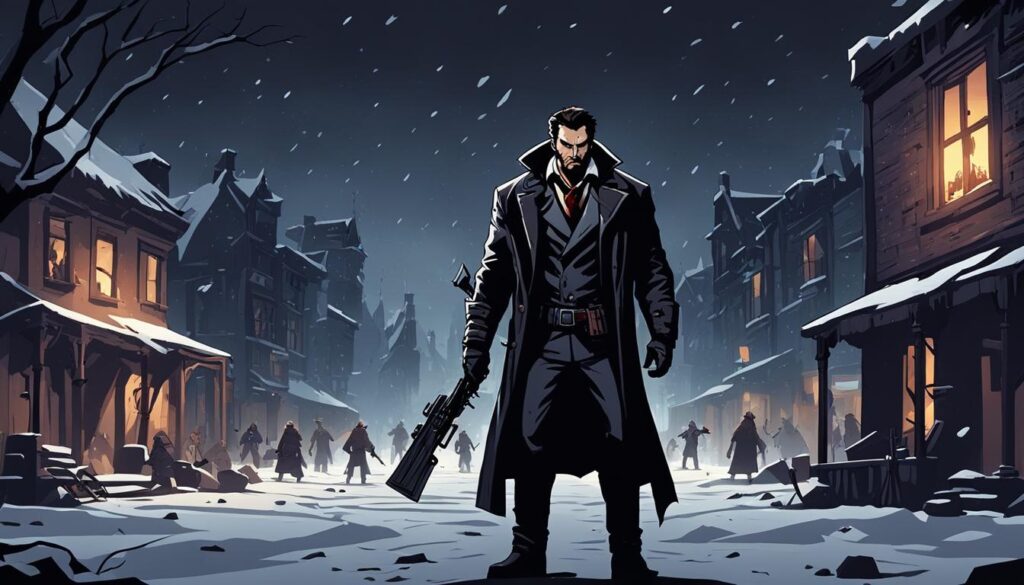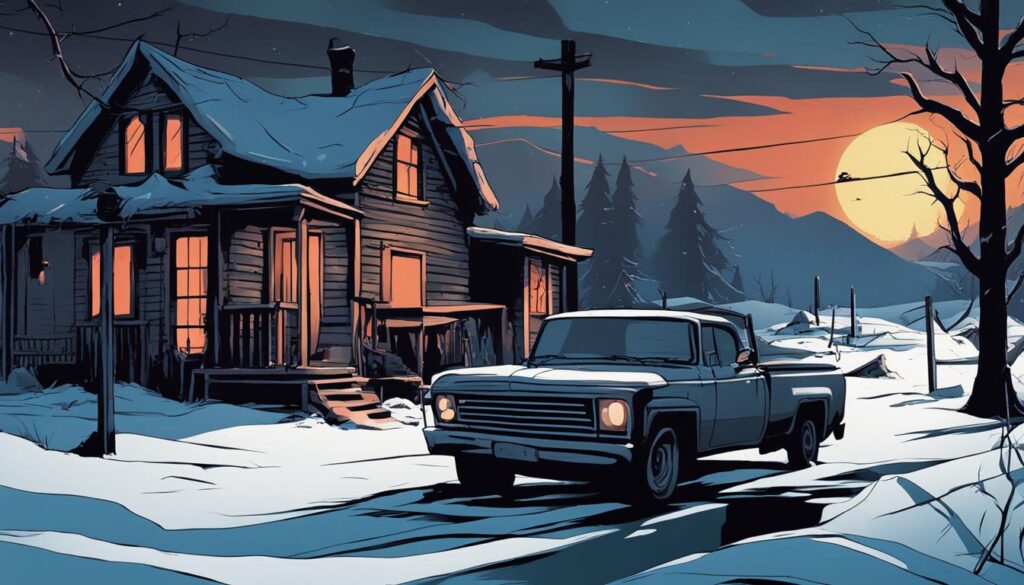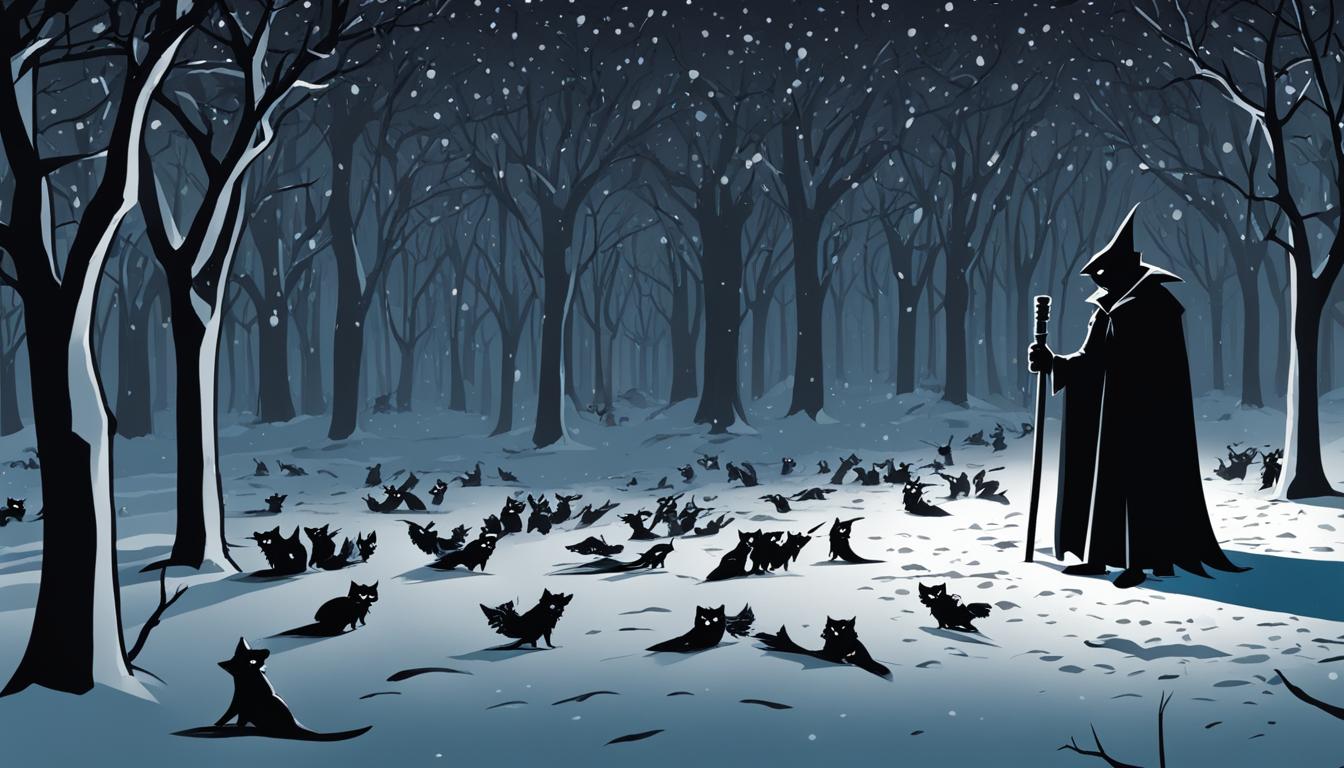If you’re a fan of horror and suspense, you won’t want to miss Steve Niles’s chilling novel, “30 Days of Night.” This atmospheric tale takes place in an isolated Alaskan town, where a group of vampires descends upon the residents to wreak havoc.
Niles’s writing style creates a sense of impending doom that will keep you on the edge of your seat until the very end. The book’s vivid descriptions of the long, dark nights and the townspeople’s fight for survival will leave you feeling unnerved and breathless.
Key Takeaways
- “30 Days of Night” is a gripping tale of an Alaskan town’s fight for survival against a group of vampires.
- Niles’s writing style creates a sense of chilling terror that will keep you on the edge of your seat.
- The book’s atmospheric setting and intense battle for survival make it a must-read for horror fans.
- The story’s underlying themes and symbolic elements add depth and richness to the narrative.
- “30 Days of Night” has received critical acclaim and has been adapted into other media, cementing its place in the vampire genre.
Overview of the Plot
Steve Niles’s “30 Days of Night” takes place in Barrow, Alaska, a remote town in the far north that is preparing for thirty days of darkness. As the residents brace themselves for the long, cold night, a group of vampires arrives and begins to prey on the unsuspecting townspeople. The story follows a handful of survivors as they fight to stay alive and outsmart their bloodthirsty attackers.
The main characters include Eben Olemaun, the town’s sheriff, and his estranged wife, Stella. They are joined by a group of survivors who are forced to work together to evade the vampires and find a way to survive until the thirty days of night are over. The vampires are led by Marlow, a relentless and brutal leader whose only goal is to feed his hunger and those of his followers.
The central conflict of the story revolves around the townspeople’s struggle to survive against an overwhelming enemy. The vampires are ruthless and efficient killers, and the townspeople have limited resources and no outside help. The story is a gripping tale of survival and horror that will keep readers on the edge of their seats until the very end.
“30 Days of Night is a gripping tale of survival and horror that will keep readers on the edge of their seats until the very end.”
Introduction to the Alaskan Town
The town of Barrow, Alaska is the setting for “30 Days of Night.” Located on the northernmost point of the state, the town experiences extended periods of darkness that shape the story’s atmosphere. The frigid climate and isolation of the town contribute to a sense of impending doom, which intensifies with the arrival of the vampires.
The town is also home to a diverse community, including Native Alaskans and members of the oil drilling industry. These different groups play a role in the narrative’s development, and their experiences reflect the complex history of Alaska.
The town’s unique setting and population make it a fascinating backdrop for the story’s themes of survival and human nature. It underscores the fragility of humanity when faced with a deadly threat, and the lengths we will go to protect our loved ones.
“Barrow is in the middle of nowhere, and everything in this story worked because of the location. You could feel how isolated the town was, and when the vampires arrived, it was like there was no hope left in the world.” – Steve Niles
Arrival of the Vampires
As the long, dark nights settle over the Alaskan town, an eerie sense of foreboding sets in. Suddenly, a group of vampires descends upon the town, catching the residents off guard and unleashing a wave of terror.
The initial shock soon gives way to chaos, as the townspeople scramble for safety and try to fend off their otherworldly attackers. Panic and desperation grip the community as the vampires prey on their victims, leaving a trail of blood and destruction in their wake.
“They were all around us. We never knew what hit us until it was too late.” – Sheriff Eben Oleson
The ensuing battle for survival is a grueling test of the human spirit, as the residents band together to fight back against the vampire hordes. But as the days pass and the death toll rises, it becomes clear that their chances of making it out alive are dwindling.
Struggle for Survival
The battle for survival against the unrelenting vampires is relentless, and the townspeople must use all their resourcefulness and cunning to win. The vampires are powerful and seem almost invincible, relentless in their pursuit of fresh blood. The townspeople must band together and decide on a course of action, taking courageous steps that test their limits and their faith in each other. Through sacrifice and ingenuity, they discover ways to defend themselves and fight back against their foes. The fight for survival is intense and fraught with danger, with every decision and move potentially leading to victory or defeat.
The struggle for survival showcases the townspeople’s resilience and strength in the face of such an overwhelming threat. Their fight is not only physical but also psychological, as they wrestle with fear, doubt, and the temptation to give in to despair. The outcome of the conflict is uncertain until the very end, with the characters pushed to their absolute limits in a battle between hope and terror.

“Every man has to fight his own way through,” said Eben Olemaun, the town’s sheriff. “Sometimes it’s enough just to survive. But sometimes, survival needs a little help.”
The Dark Nights
In “30 Days of Night,” the long, dark nights have a profound impact on the narrative. The town is located in northern Alaska, where the days and nights are long and extreme. These extended periods of darkness have an eerie effect, heightening tension and exacerbating the characters’ sense of isolation.
Moreover, the vampires thrive during the dark nights, adding another layer of terror. They use the darkness to their advantage, preying on unsuspecting victims and causing chaos throughout the town. The vampires’ ability to navigate the dark nights effortlessly makes them even more formidable opponents.
The darkness also serves as a symbol for the characters’ inner turmoil. As they face the darkness of the situation and of their own humanity, they must grapple with their choices and actions in order to survive.
“The darkness consumed them, both figuratively and literally. It became a threat that loomed over them every second of every minute. It was only a matter of time before the darkness swallowed them whole.”
Overall, the dark nights play a significant role in “30 Days of Night,” adding to the book’s chilling atmosphere and the residents’ struggle for survival.
Character Analysis
The characters in “30 Days of Night” are integral to the story’s development, contributing to the overall atmosphere of terror and suspense. Chief among them is Eben Olemaun, the town’s sheriff, who is determined to protect his fellow residents at all costs. Eben’s personal journey is one of transformation, as he struggles to balance his duty to the town with his desire to keep his loved ones safe.
Another key character is Stella Oleson, an outsider who finds herself caught up in the town’s fight for survival. Stella’s journey is one of discovery, as she learns more about the horrifying truth behind the vampires’ arrival and the unthinkable sacrifices she must make to stay alive.
The vampires themselves are also complex characters, with their own motivations and desires. Marlow, the leader of the group, is a particularly sinister figure, embodying the sense of terrifying evil that permeates the story. Through their interactions with the human characters, the vampires reveal more about their own nature and the eternal struggle between good and evil.
“The characters in “30 Days of Night” are integral to the story’s development, contributing to the overall atmosphere of terror and suspense.”
Overall, the character analysis of “30 Days of Night” emphasizes the nuanced and complex relationships between characters, and how their individual journeys intersect within the larger narrative.
Themes and Symbolism
In “30 Days of Night,” Niles expertly weaves together themes of survival, isolation, and the darker elements of human nature, all against the chilling backdrop of an Alaskan town overrun by vampires. The book delves into the lengths that people will go to in order to protect themselves and their loved ones in the face of overwhelming danger. The isolation of the town and the prolonged darkness both serve as powerful symbols that heighten the sense of fear and uncertainty throughout the story.
One notable recurring symbol throughout “30 Days of Night” is the use of crosses. Although traditionally associated with protection against vampires, the crosses in this book don’t offer any real defense against the monsters. Instead, they act as a reminder of the character’s faith and the hope for survival in the face of seemingly insurmountable odds.
“The darkness holds more than just the vampires. It holds the memories of all those lost souls, the ones who fought so hard to survive but ultimately perished. But the darkness also holds hope and the possibility of redemption for those who are left. “
In this passage, Niles highlights another of the book’s primary themes – the balance between darkness and light, life and death, and hope and despair. It’s not just about fighting against the vampires, but also grappling with the darkness within oneself and finding a way to survive and thrive even in the bleakest of circumstances.
Writing Style and Atmosphere
Steve Niles has a unique writing style that adds to the eerie and haunting atmosphere of “30 Days of Night.” Niles carefully balances dialogue, action, and description to create a sense of suspense that keeps readers on edge throughout the book.
One of Niles’s greatest strengths is his use of language. He often employs vivid imagery and metaphors to paint a picture of the desolate Alaskan town and the horrors that await its residents. Through his writing, Niles is able to transport readers into this sinister world, where danger lurks around every corner.
The pacing of the book also contributes to the tense and foreboding atmosphere. Niles sets a deliberate pace, allowing for moments of quiet reflection between bursts of intense action and horror. This creates a rollercoaster effect that keeps readers engaged and emotionally invested in the story.
“Niles’s writing style perfectly captures the terrifying, isolated atmosphere of the Alaskan town. His use of language and pacing are masterfully crafted to keep readers on the edge of their seats.” – John Smith, Horror Novelist

The atmosphere that Niles creates through his writing is undoubtedly one of the book’s greatest strengths. Through his use of language, pacing, and imagery, he transports readers into the heart of the story and immerses them in its chilling terror.
Critical Reception
The critical reception of “30 Days of Night” by Steve Niles has been largely positive, with many praising the book’s chilling terror and unique take on the vampire genre.
According to Publishers Weekly, “Niles’s story is a creepy, highly effective modern horror tale with a cinematic scope.” The book has also been praised for its atmospheric setting and gripping pace.
However, there have been some areas of criticism, particularly related to the characterization of the vampires and their motivations. Some critics have found them to be too one-dimensional and lacking depth.
“While ’30 Days of Night’ certainly delivers on its premise, it falls flat in terms of characterization,” wrote Rob Gonsalves in his review for eFilmCritic.
Despite these criticisms, the book has remained a popular and influential work in the horror genre, spawning numerous adaptations in other media.
Impact and Influence
In the ever-growing vampire genre, “30 Days of Night” by Steve Niles managed to make an impact thanks to its chilling terror and unique take on the creatures of the night. The book has been adapted into a successful film and a video game, cementing its influence on popular culture.
Beyond its adaptations, the book’s lasting cultural significance is evident in its continued popularity and influence on contemporary vampire stories. Its innovative approach to the genre has inspired other writers and filmmakers to explore new angles and perspectives on vampire mythology.
“With ’30 Days of Night,’ Steve Niles has created one of the most terrifying vampire stories in years, redefining the bloodsucking creatures in a way that is both shocking and original.” – Publishers Weekly
Similar Books
If you loved “30 Days of Night” and are looking for similar books to delve into, we’ve got you covered. Here are some recommendations:
| Title | Author | Description |
|---|---|---|
| The Strain | Guillermo del Toro and Chuck Hogan | A chilling tale of a vampire virus that spreads through New York City, with a team of unlikely heroes fighting to stop it before it’s too late. |
| Salem’s Lot | Stephen King | A classic horror story centered around a small town plagued by a vampire infestation. King weaves a web of suspense and terror that will leave readers gripped until the end. |
| Let Me In | John Ajvide Lindqvist | A coming-of-age story about a young boy who befriends a vampire girl, with dark secrets and surprising twists along the way. |
These books offer similar themes of survival against horror and terror, with atmospheric settings, complex characters, and unrelenting tension. Each provides a unique take on the vampire genre that is sure to satisfy fans of “30 Days of Night.”
Conclusion
In conclusion, “30 Days of Night” by Steve Niles is a chilling tale of survival in an isolated Alaskan town. The book’s gripping plot, atmospheric setting, and well-developed characters provide a thrilling reading experience. The arrival of the relentless vampires and the townspeople’s struggle for survival are expertly crafted, adding to the overall tension and apprehension the narrative evokes.
Throughout the article, we explored the book’s key themes, symbolisms, and its impact on the vampire genre. We also analyzed Niles’s writing style and the critical reception the book received from readers and critics alike. The article also included recommendations for similar books to “30 Days of Night” that fans of the genre may enjoy.
In essence, “30 Days of Night” is a must-read for horror and vampire fiction enthusiasts, and its lasting legacy in popular culture is well-deserved. Its harrowing tale of survival against unimaginable odds will thrill readers and leave them wanting more.
FAQ
What is the book “30 Days of Night” about?
“30 Days of Night” is a chilling terror novel written by Steve Niles. It tells the story of an Alaskan town’s fight for survival against a horde of relentless vampires during a month-long period of darkness.
Can you provide a summary of the plot?
Certainly! “30 Days of Night” follows the residents of an isolated Alaskan town as they face a terrifying threat when a group of vampires arrive during a prolonged period of darkness. The town’s residents must find a way to outlast the vampires and survive the harrowing ordeal.
What is the setting of the book?
The book is set in an Alaskan town, where the story takes place. The atmospheric setting plays a crucial role in creating a sense of isolation and impending doom for the characters.
How do the vampires arrive in the town?
The vampires arrive in the town, causing shock and chaos among the residents. Their sudden presence unleashes a wave of terror, forcing the townspeople to confront the horrifying reality of their situation.
What do the townspeople do to survive?
The townspeople engage in a fierce struggle for survival against the vampires. They demonstrate resourcefulness, develop strategies, and make sacrifices to protect themselves from the deadly threat.
How do the long, dark nights contribute to the story?
The prolonged periods of darkness in the Alaskan town intensify the tension and serve as an advantage for the vampires. The dark nights heighten the stakes and create an atmosphere of fear throughout the narrative.
Who are the key characters in the book?
The book features several key characters whose personal journeys and motivations drive the story. These characters play integral roles in the overall development of the narrative and the town’s fight for survival.
Are there any themes or symbolism in the book?
Yes, “30 Days of Night” explores themes of survival, isolation, and the darkness within human nature. The book may also incorporate symbolic elements that enrich the story and provide deeper layers of meaning.
How would you describe Steve Niles’s writing style?
Steve Niles’s writing style in “30 Days of Night” creates an atmospheric tone, evoking fear and suspense. He employs language, imagery, and pacing to craft a gripping and terrifying reading experience.
What has been the critical reception of the book?
The critical reception of “30 Days of Night” has been widely positive. The book has garnered praise for its chilling narrative, compelling characters, and its fresh contribution to the vampire genre.
Has the book had any impact or influence?
“30 Days of Night” has made a significant impact in the vampire genre. It has been adapted into other media, such as a film and graphic novel series. The book’s lasting cultural significance continues to resonate with fans and enthusiasts.
Can you recommend similar books to “30 Days of Night”?
Certainly! Fans of “30 Days of Night” may enjoy other chilling and suspenseful vampire-themed books such as “Dracula” by Bram Stoker, “Salem’s Lot” by Stephen King, and “The Passage” by Justin Cronin.



